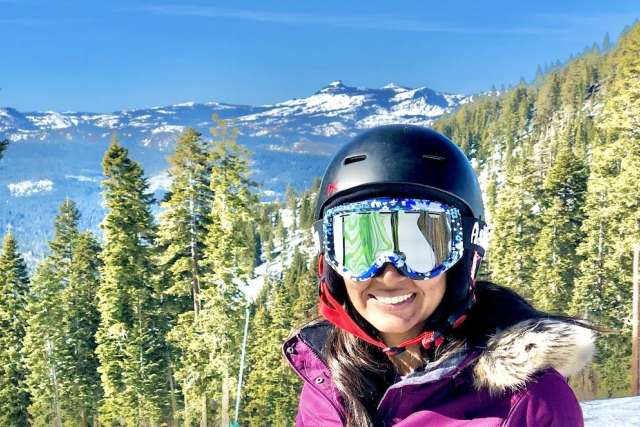Photo: Dr. Sabrina Sawlani, DO, a sports medicine physician at UCLA Health, is a skier and snowboarder. (Photo courtesy Dr. Sawlani)
If seeing Chloe Kim flip and twist her way to an Olympic gold medal in snowboarding — along with the recent snow dump in California’s Big Bear and Mammoth — has you itching to return to the slopes after a pandemic-induced absence, take heed.
While you may be imagining shredding with your friends or hitting the terrain park, your COVID-couch body might not be quite ready for all that action.
Skiing and snowboarding can potentially cause serious injuries, and the risk goes up when we’re out of practice or out of shape, says Sabrina Sawlani, DO, a sports medicine physician at UCLA Health.
“We see a lot of patients in the After-Hours Clinic [of the UCLA Department of Orthopaedic Surgery] on their way back from skiing and snowboarding,” says Dr. Sawlani, whose UCLA sports medicine fellowship included training at the urgent care ski clinic at Northstar Resort in Lake Tahoe.
“In snowboarding, we see more upper-extremity injuries, just from falling on an outstretched hand,” she says. “In skiing, we see a lot more of those lower-extremity injuries,” such as knee sprains, ligament tears and tibial fractures.
Of course, there are exceptions. Snowboard boots allow for more foot and ankle injuries than ski boots do. And falling with ski poles can lead to what’s called “skier’s thumb” — a tear of the ulnar collateral ligament, which stabilizes the thumb and allows for gripping.
Concussions are also common in both sports, and it’s worth remembering that helmets can help prevent serious head injuries.
An athlete’s age, ability, physical condition and gender affect their injury rates, Dr. Sawlani says. Female skiers, for example, are at greater risk of knee-ligament injuries than men because of anatomic and biomechanical differences. Studies find anterior cruciate ligament (ACL) tears are far more likely in female recreational skiers than in their male counterparts.
“Last year in the wintertime, I definitely saw more ACL injuries in females than males,” Dr. Sawlani says.
Preventing ski & snowboard injuries
If you haven’t been exercising much during the pandemic, give yourself at least six weeks to prepare for a downhill adventure, Dr. Sawlani advises.
Work on cardiovascular conditioning by running, biking, stair-climbing or using an elliptical machine. Target the muscles you’ll be using on the slopes: your core, hamstrings, quadriceps and glutes.
“Those are the areas I’d really try to focus on — really stretching out those areas, and your low back and shoulders,” she says. “There’s no perfect routine, but really incorporating strength, endurance, stability and your overall fitness and flexibility to keep your body safe from injury is important.”
When you get to the mountains
Make sure your gear is in good working order. If it’s been a couple of years since you used your skis or snowboard, have the equipment checked out by an expert to ensure the bindings are working properly before riding.
“Retest that release mechanism with a certified shop every year,” says Dr. Sawlani, who is a skier and snowboarder herself. “You want to test that self-release each day while you’re skiing and make sure your bindings are clean.”
Beginners and those for whom it’s been many years since the last ski trip might also consider booking a lesson with a professional instructor.
On the slopes
Once on the hill, choose your runs based on your ability and conditioning – not your inner Chloe Kim.
“If you’re out of shape, you want to select your ski runs more carefully,” Dr. Sawlani says. “Then gradually work up to the more challenging runs.”
Start with a few warm-up runs, as well, and be sure you’ve had a meal beforehand to fuel your body.
“I think a lot of people forget that hydration and nutrition are really important,” Dr. Sawlani says.
It’s essential to know how to stop and follow the rules of the mountain for merging and yielding. Generally, skiers and riders ahead of you have the right of way. Also, take extra care getting on and off the chair lift.
“Your equipment can get stuck on someone else’s equipment and that could potentially cause a serious injury,” Dr. Sawlani says.
Finally, honor your body. Rest when you need to. And if you’re feeling really fatigued, call it a day.
“A lot of injuries will actually occur on the first or the last run of the day, or even right after lunch,” Dr. Sawlani says. “If you're not warmed up, if you're fatigued, and you're just trying to get that one last run in, then you're more at risk for injury.”
Learn more about UCLA Health’s sports medicine program.
Related:
Do fitness enthusiasts really need supplements?
Cardio or weightlifting: What’s best for your fitness goals?




